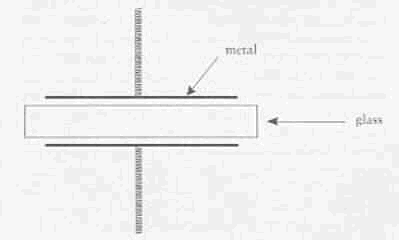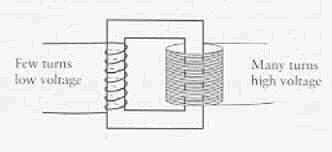*
MAXWELL & THE REVOLVING ELECTRON
In
every college text I can find it is stated that James Clerk Maxwell said the
revolving electron radiates electro-magnetic energy. In fact this was the
general consensus when the idea came up of the atom as a nucleus surrounded by
revolving electrons. The objection was raised that because the revolving
electron radiates, the electron must soon lose its energy and fall into the
nucleus. This enigma remained until in 1913 Niels Bohr explained that in the
atom the revolving electron does not radiate unless it jumps into a new orbit
with different angular momentum (different ![]() , or area), and that this
resultant radiation would be in quanta, i.e., units of angular momentum. Since
Max Planck in 1900 had discovered that radiation from a black body (i.e.,
radiation in general) occurred only in quanta, this was a confirmation of
quantum theory and explained the facts.
, or area), and that this
resultant radiation would be in quanta, i.e., units of angular momentum. Since
Max Planck in 1900 had discovered that radiation from a black body (i.e.,
radiation in general) occurred only in quanta, this was a confirmation of
quantum theory and explained the facts.
Bohr's
explanation had an even more drastic implication: the laws of quantum theory and
the laws of classical physics were different! Molar matter (matter made up of
billions of atoms) followed the laws of Newton and quantum phenomena another set
of laws. This set Albert Einstein on his quest for a unified field theory, which
has still not been found. Thus we have had three-quarters of a century of a
division of science, mainly because of Maxwell's dictum that the revolving
electron radiated electromagnetic energy.
I
do not wish to detract from Maxwell's remarkable prediction of radio waves and
other forms of electro-magnetic radiation. However, it strikes me as absurd that
even without the problem of the revolving electron a moment of attention to
known facts would have shown Maxwell to be in error. A DC magnet involves
electrons moving in a circular orbit around the coil of the magnet, and such a
magnet does not radiate electromagnetic energy!
On
the other hand, in a radio circuit that radiates electromagnetic energy, the
electrons do not revolve in a circular orbit; they oscillate, that is, reverse
their direction millions of times per second (the frequency of the radio wave).
The essential feature of an oscillating circuit is that it consists of a coil
like the DC magnet, but the continuity of the

The
electrons cannot jump across the condenser, so they have to reverse their
direction - back and forth, back and forth. The importance of this reversal of
electron motion is that it reverses the magnetic field in the coil
- very rapidly
Still
higher frequencies, which require shorter circuits, require much smaller
antennas, but there is an advantage in that the shorter wave length can be
reflected and
Let
us return to the DC magnet. Since it does produce a magnetic field filling all
space, why does this field not constitute radiation of electromagnetic energy?
How does the production of a field differ from the transmission of
electromagnetic energy? One difference is that it takes almost no energy to
create a field. When the current in the magnet is turned on there is a minute
expenditure of energy; but the maintenance of this field doesn't require
additional energy and doesn't radiate energy. It does create a force,
A familiar example of this difference is the Cadillac
stuck in the mud. The farmer comes along with his horse and pulls the Cadillac
out of the mud. How can the one-horsepower
horse pull more than the Cadillac? The horse can pull about 600 pounds of force
for a distance of 10 feet and get the Cadillac out of the mud. Doing this in
about 10
Electrostatic
force is similar. An electric charge creates a force, but it doesn't radiate
energy. To help with the distinction, suppose you pulled on the string of a
musical instrument. This would require a force, and energy so stored would not
be radiated until the string was released and vibrated. Then energy would
radiate as sound.
Similarly
if you pulled a bow-string, that would require a force. If you then released it
to shoot an arrow, the arrow would convey energy to a distant target. This
bow-and-arrow image has become a symbol for action at a distance, which also
describes the quantum of action, now known to be responsible for all conveyance
of energy from atom to atom. (When two objects collide, their atoms don't touch
because the atom is 99.99 percent pure space. Their force fields interpenetrate
and photons are created.)
Alternating
current makes possible another example of radiation because with it we can use a
transformer to change voltage - for example, to reduce the voltage of the
power lines (2000 volts) to that suitable for household appliances, electric
lights, etc. (110 volts). Such a transformer consists of two coils whose turns
differ by the same ratio as the reduction, of voltage. Or again, transformers
are used to reduce the house current from 110 volts to 1-1/2 volts for charging
batteries. For long-distance transmission, transformers raise the voltage to
200,000 volts, making it possible to carry a lot of energy through a relatively
thin wire.

The
alternating current in one coil induces in the other coil an alternating current
of different voltage. This is not possible with DC current. AC was invented by
Nikola Tesla and was an improvement over the DC used by Thomas Edison. The point
is that DC current, which consists of electrons moving in a circle, does not
radiate even from one coil to another, whereas alternating current, in which the
electrons do not revolve but oscillate, does radiate energy from one coil of the
transformer to the other and can do so only if the direction of the current
alternates at a frequency, in current practice 60 cycles per second.
All radiation is at a certain frequency. For radio the frequency is about one
million cycles per second, or one million Hertz; for light it is 10 to the 15th,
or about one quadrillion Hertz; for the 1BEV (one billion electron-volt) photons
that create particles it is 10 to the 22nd, or ten quintillion Hertz.
Now
frequency is the rate at which the magnetic field reverses, and since the field
depends on the direction of rotation of the electron which must slow down, stop,
and reverse direction, it must change its acceleration. The correct
statement of Maxwell's law should therefore be that a change of acceleration of
the electron causes radiation (or absorption) of energy. Such a law would
conform to the facts that:
1. a revolving electron, whether in an
atom or in a DC magnet, does not radiate;
2. in a radio circuit the electrons do not go around in one direction, but must
oscillate at a frequency;
3. all radiation is a frequency, that is, involves periodic change.
Frequency
(cycles per second) is division by time. But what do we divide? We might expect
that energy divided by time would be electromagnetic energy, but this is power -
foot pounds per second, or ![]() .
To obtain
.
To obtain ![]() or action (which is what is radiated), we
must divide
or action (which is what is radiated), we
must divide ![]() by time. What is
by time. What is ![]() ?
It is called moment of inertia - as in a flywheel, which smooths
out (governs) the intermittent explosions of the gasoline engine. Since
?
It is called moment of inertia - as in a flywheel, which smooths
out (governs) the intermittent explosions of the gasoline engine. Since ![]() involves
involves ![]() it is an area; divided by time it means change
of area with respect to time and confirms the rule that an electron in an
atom must change the area of its orbit to radiate electromagnetic energy. Thus
an electron in the ground state cannot radiate because its "orbit" has
no area.
it is an area; divided by time it means change
of area with respect to time and confirms the rule that an electron in an
atom must change the area of its orbit to radiate electromagnetic energy. Thus
an electron in the ground state cannot radiate because its "orbit" has
no area.
Mathematics, Physics & Reality